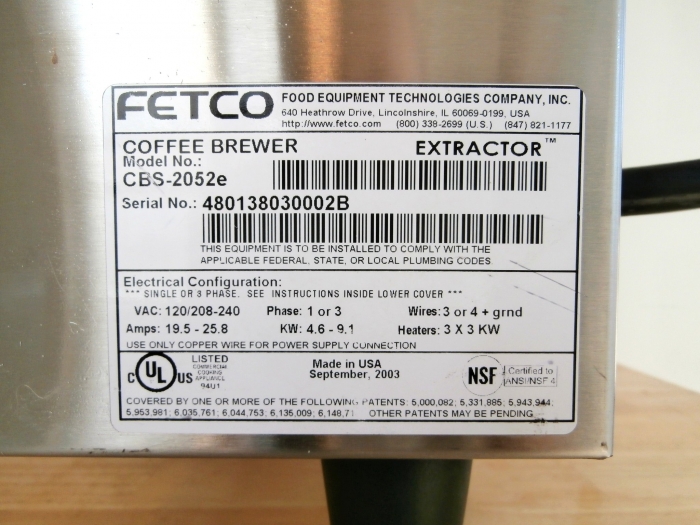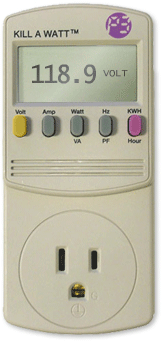Locating Wattage
You can usually find the wattage of most appliances stamped on the bottom or back of the appliance, or on its "nameplate." The wattage listed is the maximum power drawn by the appliance. Since many appliances have a range of settings (for example, the volume on a radio), the actual amount of power consumed depends on the setting used at any one time.

A refrigerator, although turned "on" all the time, actually cycles on and off at a rate that depends on a number of factors. These factors include how well it is insulated, room temperature, freezer temperature, how often the door is opened, if the coils are clean, if it is defrosted regularly, and the condition of the door seals.
To get an approximate figure for the number of hours that a refrigerator actually operates at its maximum wattage, divide the total time the refrigerator is plugged in by three.
The table below shows wattage of some typical household appliances.
| Appliance | Wattage (range) |
|---|---|
| Clock Radio | 10 |
| Coffee Maker | 900 - 1200 |
| Clothes Washer | 350 - 500 |
| Clothes Dryer | 1800-5000 |
| Dishwasher | 1200-2400 |
| Hair Dryer | 1200-1875 |
| Microwave Oven | 750-1100 |
| Laptop | 50 |
| Refrigerator | 725 |
| 36" Television | 133 |
| Toaster | 800-1400 |
| Water Heater | 4500-5500 |
| Appliance | Wattage |
|---|---|
| Aquarium | 50 - 1210 |
| Clock Radio | 10 |
| Coffee Maker | 900 - 1200 |
| Clothes Washer | 350 - 500 |
| Clothes Dryer | 1800-5000 |
| Dishwasher | 1200 -2400 (using the drying feature greatly increases energy consumption) |
| Dehumidifier | 785 |
| Electric Blanket - Single/Double | 60 / 100 |
| Fan - ceiling | 65 - 175 |
| Fan - window | 55 - 250 |
| Fan - furnace | 750 |
| Fan - whole house | 240 - 750 |
| Hair Dryer | 1200 - 1875 |
| Heater (portable) | 750 - 1500 |
| Clothes Iron | 1000 - 1800 |
| Microwave Oven | 750 - 1100 |
| Personal Computer - CPU - awake / asleep | 120 / 30 or less |
| Personal Computer - Monitor - awake / asleep | 150 / 30 or less |
| Laptop | 50 |
| Radio (stereo) | 70 - 400 |
| Refrigerator (frost free, 16 cubic feet) | 725 |
| 19" Television | 65 - 110 |
| 27" Television | 113 |
| 36" Television | 133 |
| 53" - 61" Projection TV | 170 |
| Flat Screen TV | 120 |
| Toaster | 800-1400 |
| Toaster Oven | 1225 |
| VCR / DVD | 17 - 21 / 20 - 25 |
| Vacuum Cleaner | 1000 - 1440 |
| Water heater (40 gallon) | 4500 - 5500 |
| Water pump (deep well) | 250 - 1100 |
| Water bed (w/heater, no cover) | 120 - 380 |
Amperes and Voltage

of the amp meter.
The image shows an ammeter cycling through five different measurements. 118.9 Volts, 7.49 Amps, 885 Watts, 59.9 Hertz, and 0.01 Kilowat Hours.
is licensed under CC BY-NC-SA 4.0
If the wattage is not listed on the appliance, you can still estimate it by finding the current draw (in amperes) and multiplying that by the voltage used by the appliance.
Most appliances in the United States use 120 volts. Larger appliances, such as clothes dryers and electric cooktops, use 240 volts. The amperes might be stamped on the unit in place of the wattage.
If not, find an ammeter to measure the current flowing through it. You can obtain this type of ammeter in stores that sell electrical and electronic equipment.
Take a reading while the device is running; this is the actual amount of current being used at that instant.
Phantom Loads
Also note that many appliances continue to draw a small amount of power when they are switched "off."
These "phantom loads" occur in most appliances that use electricity, such as VCR, televisions, stereos, computers, and kitchen appliances.
Most phantom loads will increase the appliance's energy consumption a few watts per hour. These loads can be avoided by unplugging the appliance or using a power strip and using the switch on the power strip to cut all power to the appliance.